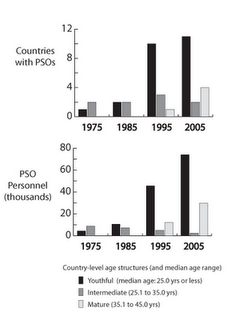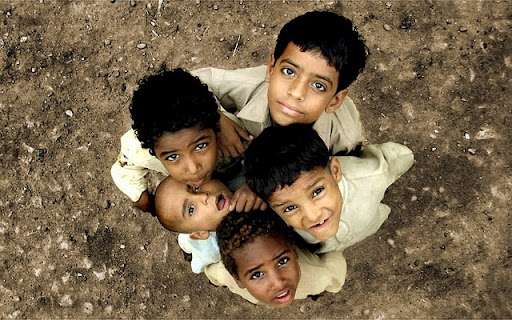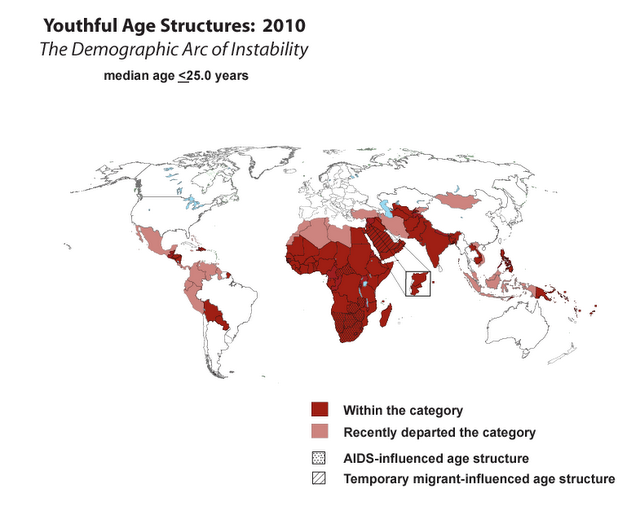-
Population Aging: A Demographic and Geographic Overview
›The original version of this article, by Richard Cincotta, appeared on the National Intelligence Council’s Global Trends 2030 Blog. It is the first post in a series on population aging, featuring Jack Goldstone, Richard Jackson, Jennifer Dabbs Sciubba, Ronald Lee, Andrew Mason, Toshi Yoshihara, Elizabeth H Stephen, David Coleman, and Eric Kaufmann.
This series, Population Aging to 2030, begins with an introductory essay aimed at familiarizing readers with some of the demographic and geographic particulars of this phenomenon, and with several key demographic terms. The term most in need of definition is, of course, “population aging.” -
Minority Youth Bulges and the Future of Intrastate Conflict
›October 13, 2011 // By Richard Cincotta
From a demographic perspective, the global distribution of intrastate conflicts is not what it used to be. During the latter half of the 20th century, the states with the most youthful populations (median age of 25.0 years or less) were consistently the most at risk of being engaged in civil or ethnoreligious conflict (circumstances where either ethnic or religious factors, or both, come into play). However, this tight relationship has loosened over the past decade, with the propensity of conflict rising significantly for countries with intermediate age structures (median age 25.1 to 35.0 years) and actually dipping for those with youthful age structures (see Figure 1 below).
-
Youth Bulge and Societal Conflicts: Have Peacekeepers Made a Difference?
›August 22, 2011 // By Richard CincottaUntil recently, the question of which countries are at the most risk of violent societal conflict could be answered with a terse, two-part response: “the young and the war-torn.” This simple characterization regarding youth and conflict worked well, until the first decade of the 21st century. The proportion of youthful countries experiencing one or more violent intrastate conflicts declined from 25 percent in 1995 to 15 percent in 2005. What’s behind this encouraging slump in political unrest? One hypothesis is that peace support operations (PSOs) – peacekeepers, police units, and specialized observers that are led, authorized, or endorsed by the United Nations – have made a difference.
From the 1970s through the 1990s, more than 90 percent of all societal conflicts broke out in countries with a youthful age structure – a population with a median age of 25 years or less. And wherever civil and ethnic wars emerged, they tended to persist. The average societal conflict that began between 1970 and 1999 continued without a one-year break in battle-associated fatalities for about six years. Some – including the Angolan civil war, Northern Ireland’s “Troubles,” Peru’s war against the Shining Path, and the Afghan civil war – endured for decades. In contrast, inter-state conflicts that began between 1970 and 1999 lasted, on average, less than two years (see the UCDP/PRIO Conflict Database).
Taking on Intra-State Conflicts Beginning in the early 1990s, however, there was a marked expansion in size and number of PSOs deployed in the aftermath of societal warfare, which appears to have dampened the persistence of some conflicts and prevented the reemergence of others. The annual number of active PSOs deterring the re-emergence of societal conflict jumped from just 2 missions during 1985 to 22 in 2005. In contrast, those led, authorized, or endorsed by the UN to maintain cease-fire agreements between neighboring states during that same period only increased from three active missions to four. By 2009, nearly 100,000 peacekeepers were stationed in countries that had recently experienced a societal conflict. About 70 percent were deployed in countries with a youthful population (see Figures 2A and B). Why the sudden expansion in use of PSOs?
Beginning in the early 1990s, however, there was a marked expansion in size and number of PSOs deployed in the aftermath of societal warfare, which appears to have dampened the persistence of some conflicts and prevented the reemergence of others. The annual number of active PSOs deterring the re-emergence of societal conflict jumped from just 2 missions during 1985 to 22 in 2005. In contrast, those led, authorized, or endorsed by the UN to maintain cease-fire agreements between neighboring states during that same period only increased from three active missions to four. By 2009, nearly 100,000 peacekeepers were stationed in countries that had recently experienced a societal conflict. About 70 percent were deployed in countries with a youthful population (see Figures 2A and B). Why the sudden expansion in use of PSOs?
According to William Durch and Tobias Berkman, this upsurge was less a change of heart or modification of a global security strategy and more an outcome of the unraveling web of Cold War international relations. Before the 1990s, the majority of PSOs were United Nations-led operations that were mandated to monitor or help maintain cease-fires along mutual frontiers. Because insurgents were typically aligned with either the Soviets or a Western power, Security Council authorization to mediate a societal conflict was difficult to secure.
This situation changed with the breakup of the Soviet Union and the initiation of PSOs by regional organizations, including operations by the Economic Community of West African States (ECOWAS) in Liberia and Sierra Leone and the NATO-led Kosovo Force in 1998-99.
Demographic Forecasting
What do national demographic trends suggest for the demand for PSOs over the next two decades? For societal conflict, political demographers foresee that the demand for PSOs will continue to decline among states in Latin America and the Caribbean – with the exception of sustained risk in Guatemala, Haiti, Bolivia, and Paraguay. Similarly, demand for peacekeeping is expected to continue to ebb across continental East Asia.
Gauged by age structure alone, the risk of societal warfare is projected to remain high over the coming two decades in the western, central, and eastern portions of sub-Saharan Africa; in parts of the Middle East and South Asia; and in several Asian-Pacific island hotspots – Timor-Leste, Papua New Guinea, the Philippines, and Solomon Islands. But even in some countries that are losing their youthful blush, domestic political relations could turn out less rosy than this simple age-structural model forecasts.
In other words, there are roadblocks to a “demographic peace.” Among them is an increasing propensity for a specific demographic configuration of ethnic conflict: warfare between state forces and organizations that recruit from a minority that is more youthful than the majority ethnic group. Examples of these conflicts include the Kurds in Turkey, the Shiites in Lebanon, the Pattani Muslims in southern Thailand, and the Chechens of southern Russia.
However, this twist on the youth bulge model of the risks of societal conflict is a discussion for another installment on New Security Beat. Suffice it to say that when political demographers look over the UN Population Division’s current demographic projections, they see few signs of either the waning of societal warfare, or the withering of the current level of demand for PSOs.
Richard Cincotta is a consultant on political demography for the Wilson Center’s Environmental Change and Security Program and demographer-in-residence at The Stimson Center.
Sources: PRIO, The Stimson Center, UN Population Division.
Chart Credit: Data courtesy of the UN Population Division 2011, PRIO, and Durch and Berkman (2006). Arranged by Richard Cincotta. -
More on Tunisia’s Age Structure, its Measurement, and the Knowledge Derived
›February 4, 2011 // By Richard CincottaThis post is a response to the questions and comments that my fellow demographers Elizabeth Leahy Madsen, Jack Goldstone, and Jennifer Dabbs Sciubba put to my recent assessment of Tunisia’s chances for democracy. I’ve divided my response to address the principal questions. (Note: Throughout, “young adults” refers to 15-24 year olds, and “working age population” refers to those between 15-64 years old.)
1. Tunisia’s age structure is still quite young – aren’t the effects associated with youth bulge still at work?
Tunisia’s age structure (median age, 29 years) is in the early stages of transiting between the instability that typically prevails in countries with youthful age structures (median age <25), and the stability that is typical of mature structures (median age between 35 to 45). I classify Tunisia’s age structure as intermediate (between 25 to 35). The Jasmine Revolution has featured a mix of both types of sociopolitical behavior: some violence and property damage, perpetuated by both the state and demonstrators; evidence of a mature, professionally-led institution (the Tunisian army); and demonstrations that are peaceful and in which women and older people participate.
By any legitimate youth bulge measure, Tunisia’s age-structure is similar to that of South Korea, Taiwan, and Thailand’s during the mid-1990s. In 2010, Tunisia’s proportion of young adults in the working age population was almost precisely the same as South Korea’s in 1993. South Korea’s median age in 1993 was 28.5, compared to Tunisia’s 29 today.
Consistent with these numerical similarities, Tunisia’s political behavior is not much different than the sociopolitical events observed in South Korea, Taiwan, or Thailand in the early 1990s when these countries experienced an age structure of similar maturity. As these countries matured, political violence and destructive protests occurred less frequently but dissidence lingered in more peaceful, isolated incidents. For example, South Korea experienced several deadly anti-U.S. demonstrations in 1988-89 and only a few minor incidents in the early 1990s. By 1993, the public was demonstrating against extremism, and public protest had turned peaceful and symbolic.
Even today, public protest in Thailand (median age, 33 years) is commonplace. Thai political rights are constrained, and accordingly the country has been dropped in Freedom House’s annual assessment of political freedoms from “free” to “partly free.” However, unlike the student and worker riots that occurred sporadically throughout the 1970s and 80s, Thai demonstrations are typically non-confrontational political rallies attended by T-shirt-clad grandparents and families who bus into town for the event.
2. Why use the population’s median age rather than the youth bulge measures that political demographers (including me) have previously employed with considerable success?
I’m experimenting, and so far, I’ve found that median age replicates prior published results concerning civil conflict and stable liberal democracy. Median age’s ability to span the entire length of the demographic life-cycle of the state is its primary advantage. Youth bulge indicators do not; neither do indicators focused on working-age adults, nor those measuring seniors. In addition, median age integrates many factors that change in parallel with the age-structural transition, including income, education, women’s participation in society, secularization, and technological progress. Still, median age doesn’t track the youth bulge measures perfectly, so why use it?
Currently, foreign affairs policymakers see few linkages between a country’s (1) risk of civil and political violence; (2) its propensity to accumulate savings and human capital; (3) its chances of attaining stable liberal democracy; (4) the challenges that arise to adequately funding pensions and senior healthcare; and (5) rapid ethnic change in low fertility societies. Political demographers understand that these effects on the state are indeed related and that the rising and ebbing probabilities associated with these effects occur sequentially. Understanding this sequence is key to understanding the world’s international relations future. Median age allows political demographers to view that sequence.
As Jennifer Sciubba points out, the disadvantage of median age is its apparent lack of resonance with theories that have historically informed political demography, including theories of cohort crowding, dependent support, and life-cycle savings. I don’t believe that political and economic demographers should (or will) abandon these indicators, which help them observe the inner workings of age-structural phenomena. Nonetheless, I find it useful to make analysts aware of the advantageous and disadvantageous pressures that age structure exerts across the entire demographic life cycle of the state.
3. Can the deposed regime’s multi-faceted problems be captured by the age-structural transition?
No, age-structure cannot account for leadership – clumsy or deft, corrupt or honest. The method is limited to predictions that draw on sociopolitical behaviors that are associated with age structures, or by knowledge gained from deviations from these predictions. Nonetheless, I question the value of many of the after-the-fact observations of the Ben Ali Regime. Tunisia’s fallen regime was indeed oppressive, corrupt, and nepotistic – but so are most authoritarian regimes in Asia and Africa. Lack of job creation and preferential access to employment are valid grievances across much of the developing world, but the lack of informal sector statistics renders country comparisons difficult.
Some analysts have hypothesized that global warming has been a contributor (also applied to Egypt), others point to economic globalization and pressures on Tunisia’s middle class. Whether these assertions are wrong or right, it is difficult for me to see how such post hoc observations add to analysts’ knowledge of regime change or democratization or help them explain why other countries with similar problems have not undergone similar sociopolitical dynamics. In contrast, hypotheses based on quantitative relationships between age structural indicators and sociopolitical behaviors generate testable and repeatable predictions that can be checked and held accountable after an event.
What I find most surprising about the age-structural approach to predicting liberal democracy is how often states ascend to liberal democracy as they approach, or pass, the 0.50 probability mark. If either “triggers” of regime change or key institutions were very important, this observation would be unlikely.
A Concluding Note on Political Demography
If political demographers are serious about advancing policymakers’ ability to understand the present and future of global politics and security, political demography will have to become a scientific discipline – a field of study in which assertions are consistently tied to data and tested whenever possible. In many cases, though not all, we’re lucky – demographers provide us with timely estimates and projections at the national level. Nonetheless, for our field to succeed, political demographers must take full advantage of these data, encourage sub-national data to be collected and published, and make a clean break from the tradition of conjecture that currently pervades international relations.
Richard Cincotta is a consulting political demographer for the Wilson Center’s Environmental Change and Security Project and demographer-in-residence at the Stimson Center.
Sources: CIA World Factbook, Freedom House, Jadaliyya.
Image Credit: Adapted from “Viva the Tunisian Revolution,” courtesy of flickr user freestylee (Michael Thompson). -
Tunisia’s Shot at Democracy: What Demographics and Recent History Tell Us
›January 25, 2011 // By Richard Cincotta
While events in Tunisia, beginning mid-December and leading ultimately to President Ben Ali’s departure within a month, have rocked the Arab world, they leave an open question: Will Tunisia’s “Jasmine Revolution” ultimately lead to the Arab world’s first liberal democracy? [Video Below]
-
Women and Youth in 21st Century Statecraft
›January 10, 2011 // By Richard CincottaWhether one supports or finds fault with current (and envisioned) U.S. diplomacy and international development processes and practices, most foreign policy analysts and academics will recognize the first Quadrennial Diplomatic and Development Review (QDDR) as a landmark document. In my opinion, the QDDR – titled Leading Through Civilian Power – is essential reading for those who seek a career in government or who otherwise need to understand the nature and purpose of the work that foreign service officers and USAID missions perform overseas.
-
Whither the Demographic Arc of Instability?
›December 14, 2010 // By Richard Cincotta
After the Berlin Wall came down in 1989, the demand for geostrategic mapping went up. Pentagon geographers revised maps almost monthly in order to keep pace with the rapid sequence of events – the toppling of Eastern Europe’s communist regimes, the rise of pro-Western liberal democracies in their place, and the reunification of Germany. Then came more borders, and even more maps: the breakup of the Soviet Union and the withdrawal of forces from former Warsaw-Pact states, the splintering of Yugoslavia and Czechoslovakia, and requests for accession to NATO. When, in the late 1990s, it became apparent that the end of the Cold War would have little effect on the emergence of civil and ethnic conflicts in Africa, Asia, and Latin America, and that a network of militant Islamist organizations had coalesced across Muslim Asia and Africa, strategic mapmaking shifted focus to identifying conditions in the Global South.
-
The Future of Sub-Saharan Africa’s Tentative Fertility Decline
›August 25, 2010 // By Richard CincottaIn her recent post on The New Security Beat, Jennifer Sciubba argues that the medium-fertility variant projection published in the UN Population Division’s biennial projections — the source of most future data published in the Population Reference Bureau’s 2010 World Population Data Sheet — forecasts an unrealistically low total fertility rate (TFR) for sub-Saharan Africa in 2050, at a rate of 2.5 lifetime childbirths per woman.
Showing posts by Richard Cincotta.













